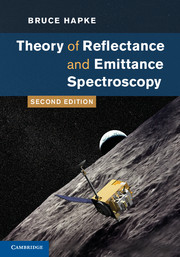Book contents
- Frontmatter
- Contents
- Acknowledgments
- 1 Introduction
- 2 Electromagnetic wave propagation
- 3 The absorption of light
- 4 Specular reflection
- 5 Single-particle scattering: perfect spheres
- 6 Single-particle scattering: irregular particles
- 7 Propagation in a nonuniform medium: the equation of radiative transfer
- 8 The bidirectional reflectance of a semi-infinite medium
- 9 The opposition effect
- 10 A miscellany of bidirectional reflectances and related quantities
- 11 Integrated reflectances and planetary photometry
- 12 Photometric effects of large-scale roughness
- 13 Polarization of light scattered by a particulate medium
- 14 Reflectance spectroscopy
- 15 Thermal emission and emittance spectroscopy
- 16 Simultaneous transport of energy by radiation and thermal conduction
- Appendix A A brief review of vector calculus
- Appendix B Functions of a complex variable
- Appendix C The wave equation in spherical coordinates
- Appendix D Fraunhofer diffraction by a circular hole
- Appendix E Table of symbols
- Bibliography
- Index
15 - Thermal emission and emittance spectroscopy
Published online by Cambridge University Press: 05 January 2012
- Frontmatter
- Contents
- Acknowledgments
- 1 Introduction
- 2 Electromagnetic wave propagation
- 3 The absorption of light
- 4 Specular reflection
- 5 Single-particle scattering: perfect spheres
- 6 Single-particle scattering: irregular particles
- 7 Propagation in a nonuniform medium: the equation of radiative transfer
- 8 The bidirectional reflectance of a semi-infinite medium
- 9 The opposition effect
- 10 A miscellany of bidirectional reflectances and related quantities
- 11 Integrated reflectances and planetary photometry
- 12 Photometric effects of large-scale roughness
- 13 Polarization of light scattered by a particulate medium
- 14 Reflectance spectroscopy
- 15 Thermal emission and emittance spectroscopy
- 16 Simultaneous transport of energy by radiation and thermal conduction
- Appendix A A brief review of vector calculus
- Appendix B Functions of a complex variable
- Appendix C The wave equation in spherical coordinates
- Appendix D Fraunhofer diffraction by a circular hole
- Appendix E Table of symbols
- Bibliography
- Index
Summary
Introduction
The region of the electromagnetic spectrum in the vicinity of 10-μm wavelength is referred to as the mid-infrared, but is also called the thermal infrared because objects at the temperature of the Earth's surface emit radiation strongly there. It is important because many materials have strong vibrational absorption bands at these wavelengths (Chapter 3). In most remote-sensing measurements these bands can be detected only through their effects on the radiation that is thermally emitted by the planetary surface being studied. Many substances have overtone or combinations of these bands at shorter wavelengths; although they can be observed in reflected light, their depths and shapes may be affected by emitted thermal radiation. It will be seen that there are complementary relations, known as Kirchhoff's laws, between reflectance and emissivity at the same wavelength. Hence, much of the preceding discussions of reflectance can also be applied to emissivity.
Figure 15.1 shows the spectrum of sunlight reflected from a surface with a diffusive reflectance of 10%, compared with the spectrum of thermal emission from a black body in radiative equilibrium with the sunlight, at various distances from the Sun. Clearly, thermal emission can be ignored at short wavelengths, and reflected sunlight at long, but at intermediate wavelengths the radiance received by a detector viewing the surface includes both sources.
In this chapter, expressions will be derived for the radiant power received by a detector viewing a particulate medium, such as a powder in the laboratory or a planetary regolith, when either or both reflected sunlight and thermally emitted radiation are present.
- Type
- Chapter
- Information
- Theory of Reflectance and Emittance Spectroscopy , pp. 412 - 439Publisher: Cambridge University PressPrint publication year: 2012
- 2
- Cited by

